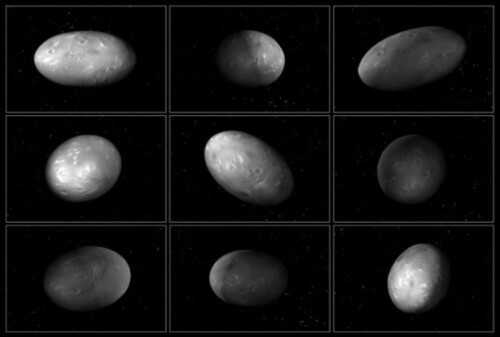If you lived on the moons of Pluto Nix or Hydra, you would have a hard time setting the clock. This is because you can never be sure when or even from which direction the sun will rise. A comprehensive analysis of the moons from the Hubble Space Telescope shows that these two moons, Nix and Hydra, rotate unexpectedly.

If you lived on the moons of Pluto Nix or Hydra, you would have a hard time setting the clock. This is because you can never be sure when or even from which direction the sun will rise. A comprehensive analysis of moons from the Hubble Space Telescope shows that these two moons, Nix and Hydra, rotate in an unpredictable manner.
:
This visualization shows the chaotic swirl of the holiday moon Nix around Pluto. The series of computer simulations shows how the direction of the moon changes according to the unpredictable complex dynamic rules as it orbits the double planet - Pluto-Charon. The scientists believe that the other two moons Cerberus and Styx behave similarly, but this requires further research.
"Hubble has provided us with a new view of Pluto and its moons and it reveals a cosmic dance with a chaotic rhythm," says John Gornsfeld, NASA's assistant administrator for science missions at NASA Headquarters in Washington. "When New Horizons passes through the system in July we will have a chance to see what these moons look like up close."
Why the chaos? Because the moons are embedded in a dynamically changing gravitational field by the two central bodies in the system, Pluto and Charon orbiting each other. The changing gravitational field causes a torque to be sent to the smaller moons and causes them to spin in an unpredictable way. This moment is strengthened by the fact that the shape of these moons is more elliptical than circular.
These surprising results were obtained in a study conducted by Mark Showalter (Showalter) from the Seti Institute in Mountain View California and Doug Hamilton from the University of Maryland and it appeared in the June 4 issue of the journal Nature.
"Prior to Hubble's observations, no one predicted the interactive dynamics of the Pluto system," says Schwalter. "Our research provides evidence of the series of events that led to the creation of the system."
Hubble, which monitors Pluto's four outer moons, revealed that three of them, Nix Styx and Hydra, are trapped together in resonance in a precise ratio between their orbital periods. "This locking causes their movements to synchronize in a way similar to that of the three large moons of Jupiter," commented Hamilton. "If you were sitting on Nix, you would see Styx orbiting Pluto twice every three orbits of Hydra.
Hubble provided evidence that their orbit around Pluto is also chaotic "however, this is meaningless given that the entire system is on the verge of disintegration," said Wolter, "we need to know much more about the system before we can determine its long-term fate."
Much to the surprise of the astronomers, Hubble also discovered that the moon Cabros is as black as a lump of coal, while the other three are as bright as white sand. It is estimated that the pollution caused by the dust blown from the moons due to the impact of meteorites was supposed to blacken all the moons and give them a uniform appearance. "This is a provocative result" added Showalter.
The New Horizons spacecraft that will pass through the Pluto-Charon system in July 2015 (when the zenith will be on July 14), may help solve the mystery of the black moon and the other oddities discovered by Hubble. The new discoveries are used by the mission scientists in planning the scientific observations of New Horizons.

3 תגובות
Gideon
Chaotic motion describes a situation where the state of a system at any given moment is extremely sensitive to the initial conditions. Without knowing the initial conditions, the situation at any other moment cannot be known.
A "simple" example is a double pendulum - a pendulum at the end of which there is another pendulum. Wikipedia has a very nice explanation about it. A very famous example is the climate.
a question:
This means that it has been proven that there are no fixed rules for the movement of the moons or maybe there are, but we don't know these rules?